The days of shore power limitations and fuel generator noise are fading. With solar power for RVs and vans, you can gain a new level of energy independence. One that lets you decide the best place to stay, without concerns of power outlets.
Setting up a new solar system in your RV or campervan can be intimidating. But it’s actually easier than you think. Thanks to the growing world of solar power innovation, you can use things like solar generators and solar power kits to take the heavy lifting off of your shoulders.
In this post, we’ll go over the basics of van and RV solar power. Then we’ll dive into how to install solar panels on your RV, including everything from your roof to the end device. Finally, we’ll quickly touch on the cost of installing solar panels on an RV or campervan.
We carefully select the products and services we link to. If you buy through our links, we may earn a commission. There’s no extra cost to you and it helps us provide this information.
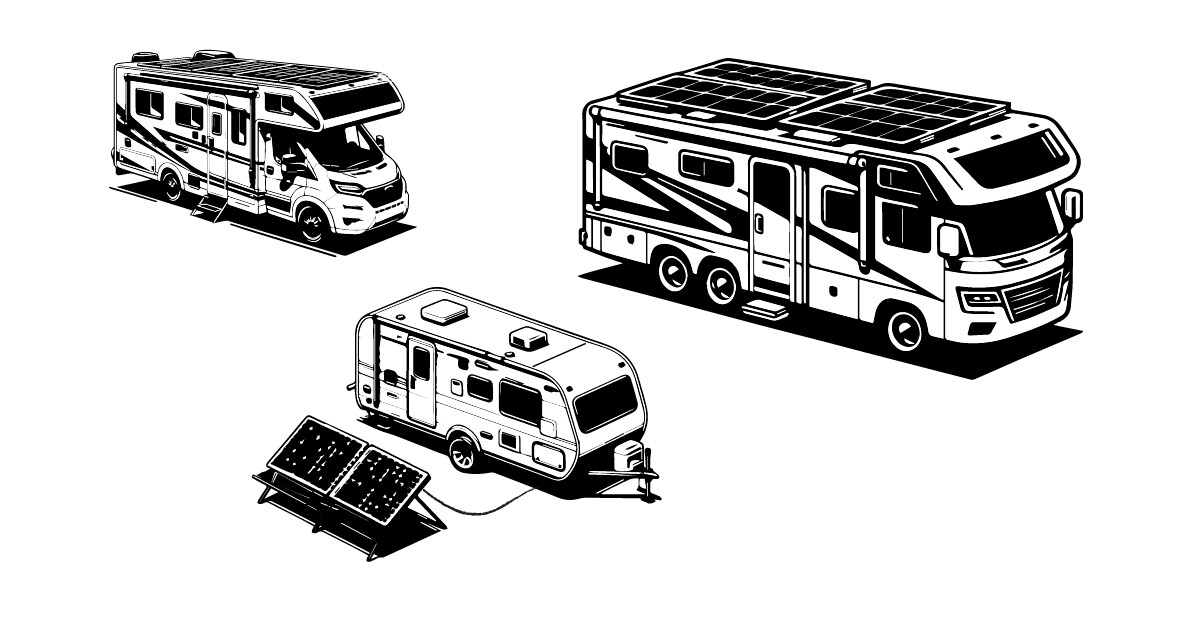
The Shortcut: How to Quickly Install RV Solar System
Before we dive into the deep end, I’m going to share a hidden secret. If you buy a solar generator, you can skip about 95% of this article and quickly install an RV solar system without a hassle.
A solar generator is a portable device that helps generate, store, and use solar power. All in one portable, magical box. It’s well-engineered and available in all sorts of sizes and at many price levels. You can find one to meet your needs and budget.
How solar generators for RVs work is simple:
- Connect the solar panels to the solar generator. You can use rooftop solar panels or portable ones.
- Connect your solar generator to your RV. In most cases, you can literally just plug it into your shore power outlet. If you want, you can wire more sophisticated connections.
- As the sun shines, energy flows from the panels into your solar generator. You can use it immediately or let it build up in the battery for later use.
That’s it. The bigger the solar panels and the bigger the solar generator, the more stuff you can power.
You can start with a small system, maybe 200W of portable solar panels and a 700Wh solar generator. This will keep phones charged, power lights, and handle some small appliances.
Or you can go wild. Install 1,000W of solar on your RV’s roof and get a 4,000Wh (4kWh) solar generator. This will likely handle most of your RVs needs. People can now power their entire homes with solar generators. You can find one that works for your RV.
This is by far the easiest and quickest way to get solar power in an RV. Get some solar panels and a solar generator. Use two cables to connect the entire system. Hit the road.
Sounds too good to be true? It gets even better. Since solar generators are portable, you can also use this device as a home backup power solution. Or bring it to the park or any event. You now have a portable solar power system that can work quite literally anywhere you bring it, with or without your RV.
Interested in seeing some of the best solar generators? Head over to our full review:
You can also browse through the entire product lineup and detailed company information for these top brands: EcoFlow Solar Generators, Bluetti Solar Generators, and Anker Solar Generators.
Now let’s back things up and talk about the details.

The Basics of Solar Power for RVs
You don’t need a degree in electrical engineering to understand how solar power works in an RV. With a few basic ideas, you can pick out the right parts and add solar to your RV or campervan.
An RV solar system:
- Starts by generating power with solar panels
- Electricity goes through a charger to a battery pack
- Battery stores energy so you can use it as you need
- Power inverter and other fine details make it all come together to power devices
Now let’s dive a little deeper into each part and talk about connections.
Throughout this, it might help to think of electricity flowing, like water. The solar panels start the flow like a water spring. Batteries store it like a reservoir. Charger, inverters, connectors, etc. are like the plumbing and control valves.

Generating Power: Solar Panels and More
Adding solar panels to your RV creates another power source. You probably have a shore power outlet and perhaps a fuel generator. Now you can have another power source.
The amount of solar panels, rated in Watts (W), determines how much electricity they generate. In order words, how much electricity flows out of them.
How many solar panels do you need to power an RV or campervan? It depends on your needs and your battery storage.
Here are some very general ideas of how many solar panels and what they can power in your RV:
- ~200 to 300W: A small amount of solar, like a slow trickle, that can charge phones and power lights but not too much else
- ~500 to 700W: Pretty good starting point for many RVs that can handle many devices and some appliances
- 1,200W and up: Getting serious about solar, able to power large appliances, especially with the right battery pack or solar generator
To know how many solar panels you need, you’ll need to calculate your solar panel needs.
You can mount these panels on the roof of your RV. Then you basically forget about them entirely. The downside is that you must park in direct sunlight. We’ll go over the details of how to install panels below.
Or you can use portable solar panels that fold up for storage and transit. Then you can park in the shade and throw the solar panels in any pocket of sunlight. More flexible, but makes setting up camp a little more tedious. It’s also more challenging for large solar arrays.
Whatever you choose, the solar panels start the flow of electricity. The bigger your array, the more the electricity is flowing.
Click here to learn more about How to Your Own Generate Electricity. That article covers solar, wind, hydro, fuel generators, and more.
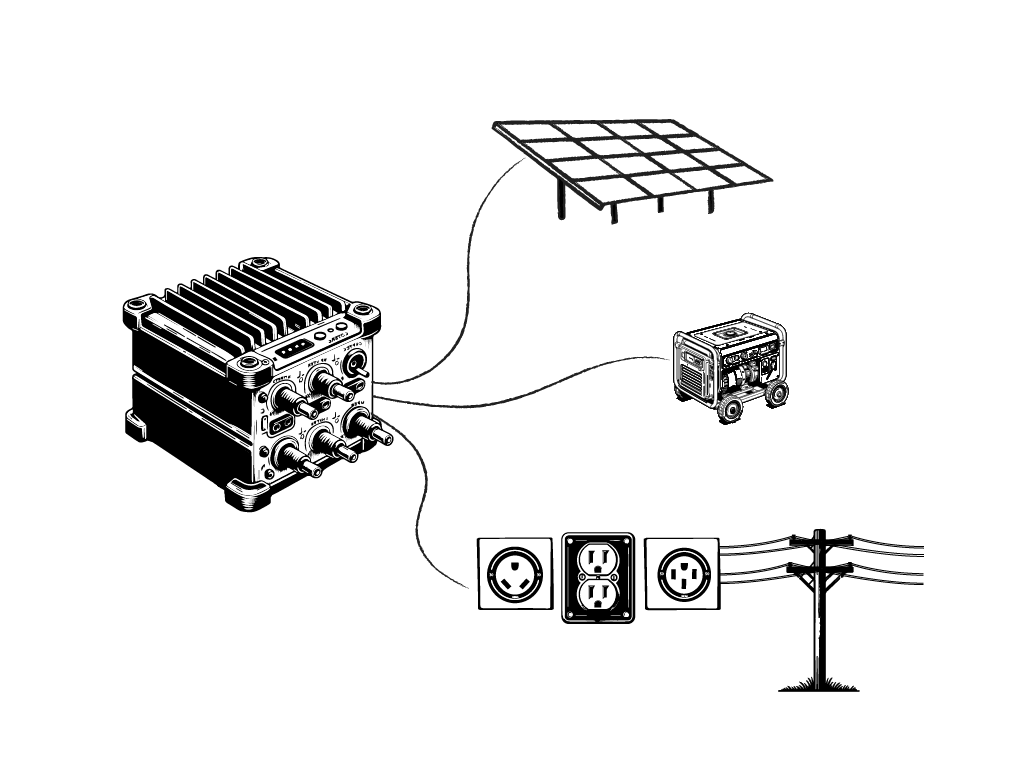
Controlling the Flow: Solar Chargers
The next thing you’ll need to add a solar system to your RV is a solar charger. This is an essential component between the solar panels and the battery. It’s very similar to a shore charger, which is an AC to DC charger. A solar charger is a DC to DC charger.
A solar charger monitors the status of your battery and solar panels. It sends electricity to the battery until it is full, then it stops the flow.
Putting solar panels directly on a battery would be like putting a hose in a pool and walking away. Eventually, the pool is going to overflow and cause problems. Very serious battery problems.
Solar generators have an integrated solar charger. You just plug the solar panels directly into the portable solar generator device.
If you want to build your own van or RV solar system, you’ll have to install an appropriately sized charger between the solar panels and battery. It must be able to handle the voltage and current (amperage) coming off the panels, which depends on the solar panels you install and the way they are connected (series vs. parallel).
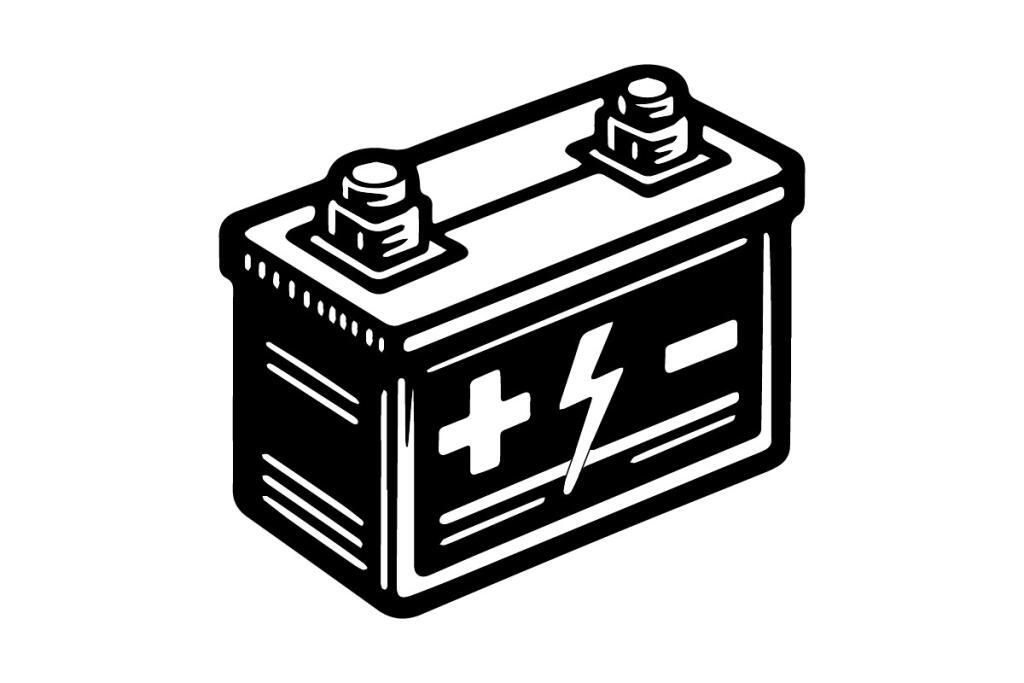
Storing Energy for Later: Solar System Batteries for RVs and Campervans
Obviously, solar panels don’t create energy without sunlight. So how do solar panels work at night? They charge the battery during the day. Then you can use solar power whenever you want. Dark nights, stormy days, etc.
The size of the battery you need for your RV’s solar system depends on a few things: What devices do you want to run on solar power? What solar panels do you have? How long do you want to be able to use your devices?
Battery capacity is easiest to measure in Watt-hours (Amp-hours is also popular, but changes depending on voltage).
For more details about the right battery for your solar system, read our article on the Best Solar Batteries.
Here are some examples of battery sizes and what they can power:
- Entry-level RV battery:
- 1,200Wh (100Ah at 12V) capacity
- Pair with about 200 to 300W solar panels
- Powers your lights, charges phones, and might be able to run a small 12V fridge
- Good to start, but you’ll want more as soon as you can
- More respectable battery:
- 4,800Wh (400Ah at 12V) capacity
- Pair with about 500 to 700W of solar panels
- Powers lights, phones, entertainment systems, and some larger electrical devices
- Solid place to be that will bring decent solar power to your RV
- Serious setup:
- 12,000Wh (1,000Ah at 12V) capacity
- Pair with about 1,200W or more of solar panels
- Powers basically anything in your RV or campervan, a very capable off-grid RV energy system
- Going to weigh a lot and will be a significant investment
Your RV likely already has a leisure or house battery for your electrical system. Unfortunately, these are usually quite small. This battery system is separate from the starter battery for the engine.
Upgrading your battery is possible. You’ll have to understand many details about your RV’s particular system. What voltage is it at? Can the chargers handle the battery chemistry you want to use? Are all devices connected to it or are some only going to the shore power?
Once again, turning to solar generators takes the heavy lifting out of the equation.
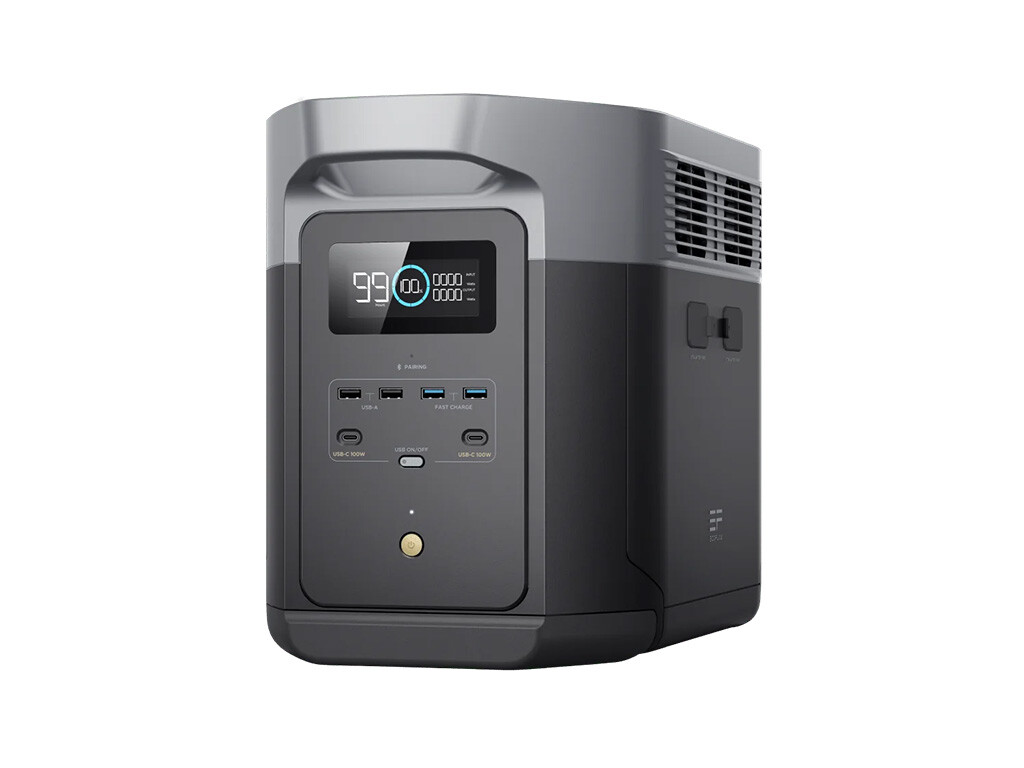
|
EcoFlow DELTA 2 Max |
D2M on EcoFlow D2M on Amazon |
If you buy a solar generator, it will act like an entirely separate battery bank. It will expand your electrical storage without having to fuss with the existing setup. You don’t connect it directly to your RV’s battery bank unless you want to.
You can route it through your existing shore power charger. Large solar generators have 30-amp outlets. But even if it just has a 15-amp outlet, you can always get an adapter to use with your 30 or 50-amp shore power input.
You can also install another shore power charging outlet dedicated to the solar generator. This is great for keeping it tucked inside of a storage box.
Your RV’s electrical system will simply use it like any other shore power supply. It is insanely easy with a solar generator for RVs.

Getting from DC to AC: Power Inverters
One essential component of most solar systems is a power inverter. Solar panels and most batteries store energy in a form called direct current (DC). But many appliances and household plugs run on alternating current (AC).
An inverter changes the electricity from DC to AC. Inverters vary in size, based on the devices they can power.
If you just need a small trickle, like for a blender, you can get a small inverter and use a small battery bank. But if you want to power a serious AC device, like an air conditioner, then you need a larger inverter and a larger battery bank. Microwaves are usually in the middle, but make sure to look at the input wattage needs of the microwave, not the output.
Some RVs come with an inverter. But others don’t. If some of your electronics don’t work unless you’re hooked up to shore power, you probably do NOT have an inverter.
Guess what? Solar generators handle this for you. A major part of any solar generator is the inverter inside. It’s a size that’s usually ideal for the battery bank they’re paired to.
This inverter powers the AC outlet which connects to your shore power AC outlet, including 30-amp or 50-amp outlets. They make adding solar power for RVs a breeze.
Otherwise, you’ll have to figure out what inverter you need, then connect that to the battery pack you select.
Head over to our article on How Inverters Work to see more detailed information.
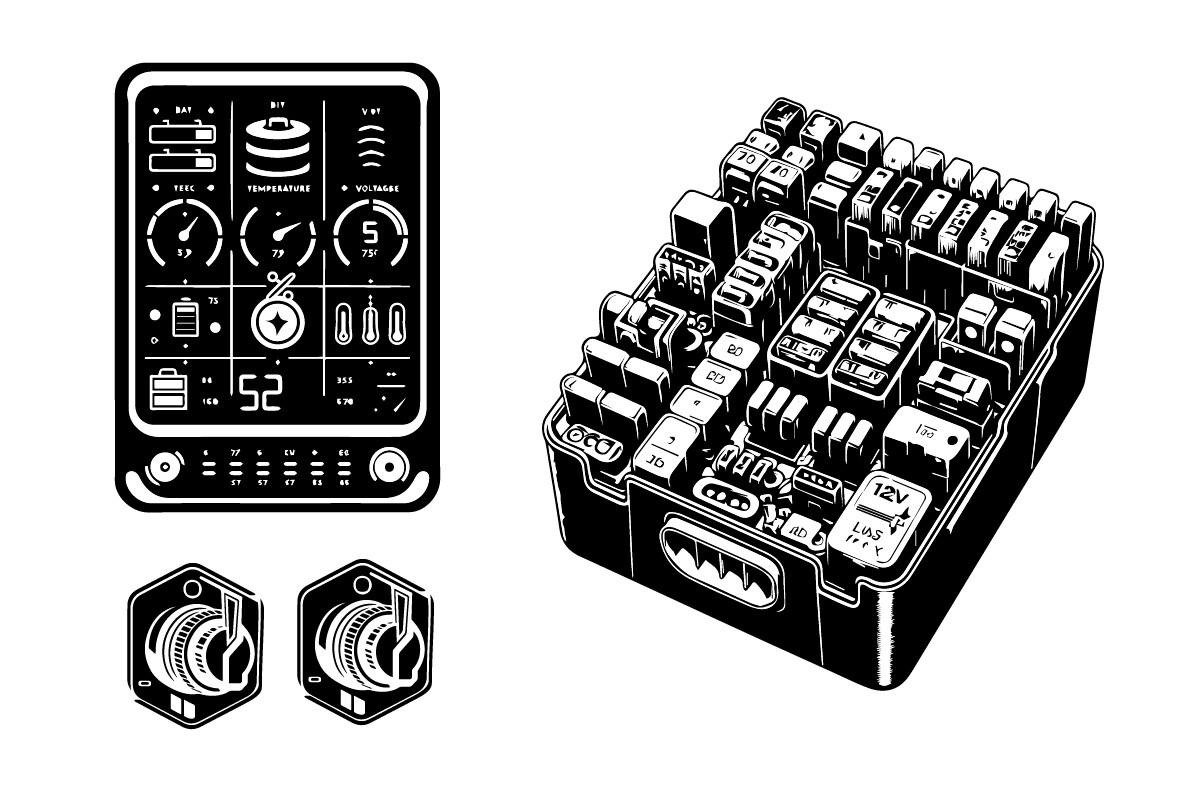
Special Equipment: Monitors, Fuses, Cutoffs, and More
There’s a good amount of fine details to understand if you want to build your own RV solar system.
Most major lines where electricity flows will need an appropriately sized fuse (measured in amps). You’ll need to put a cutoff in at least two places: between the solar panels and battery, and another that cuts the battery supply entirely.
You’ll also need to calculate the appropriate gauge of wire to use, for both DC and AC circuits. And properly crimp, seal, and connect all of the wires. Large DC wires close to the battery often require a specialized tool.
Finally, a device that monitors your entire system is crucial. You want to be able to watch how much power:
- The solar panels are generating
- The battery has left
- Your devices are using
And yet again, the solar generator does ALL of this for you.
The only thing you need is the cable from the solar panels to your solar generator (which is often included when you buy the solar panels) and the cable from your generator to your shore power outlet. Which you probably already have for shore power use.
That’s how easy it is to get solar power for RVs.
If you want to get fancy, you can use the DC output on the solar generator to wire that into your system. In that case, it’s still just one line from your solar generator to your RV. Still insanely simplified.
You might spend a little more on the solar generator than separate components. But it will save loads of time. And much more importantly, it ensures your safety and is backed by a warranty. You’ll even have access to robust customer service and community support networks.
Solar generators are well worth it.

Figuring It Out: Van and RV Solar Installation
That was a lot of information. But hopefully it gave you a nice foundation to run with. Now it’s time for a few more of the fine details that can help you actually install the solar power system for your RV or campervan.
Solar Generators: Easy and Instant
If you want to keep things simple, a solar generator does the trick. By integrating the charger, battery, inverter, and all of the small details into one magic box, you really don’t have to think about a lot.
You simply select the solar panels and solar generator you want, then connect them to your shore power outlet.
You can install solar panels on your roof or use portable ones. Use the solar generator from anywhere you can get the cords to it. Or mount it in a storage area that’s convenient.
Taking it up a notch, you can connect the solar generator to a dedicated charger. Popular options include:
- Add another hidden shore power outlet: Split and utilize the existing power input. Just install a transfer switch on the line going to your existing shore power outlet. Or connect a separate shore power charger directly to your RV’s electrical circuit.
- Add a DC charger: This will take your solar generator’s DC output and safely connect it to your RV’s battery or DC fuse box.
Best Solar Power Kits for RVs and Campervans
There’s a compromise that lands between solar generators and an entire DIY system. These are known as solar kits or solar power kits, now offered by a few of the top solar brands.
Solar power kits are bundles of solar-power products that include most everything you need to create a DIY solar system.
For example, Renogy has solar kits which include the solar panels, wires, and solar charger. They are all well suited to work together and will add a solar power energy source to any existing battery bank.
EcoFlow has more comprehensive solar power kits. They cover everything from solar panel generation to distribution. That means the battery pack, chargers, inverter, fuse boxes, everything can be sold in one pack.
The EcoFlow system is great for campervan systems or if you want to really renovate your RV solar system. The Renogy pack can work well with existing RV circuits, as long as you’re happy with the battery bank and you don’t need an inverter.
Both are still a little tricky. But not as complicated as the next type.

|
EcoFlow Power Kits All |
Buy on EcoFlow |
DIY Solar System for RVs and Vans
You can always buy things separately and handle it on your own. Up until the recent introduction of solar generators and solar power kits, this is how any do-it-yourself person did it.
But since this is complicated and involves electrical concerns, many others hired professionals. While this helps with safety, it increases cost. And even if you hire a professional, the system will have quirks and may need servicing. Creating an off-grid solar system for RVs can be tricky.
If you get a solar generator, everything is literally in a box. It stops working, you call the company and trust their warranty process. You can also trust the literally thousands of other people that are using the same exact setup. It’s no longer a one-off custom creation that opens the door to a lot more problems.
To create a DIY solar system for RVs on your own, here are the main considerations:
- Power consumption: Calculate how much power your devices will use in watts to get an idea of what size solar panels and battery bank you want.
- Solar panels: Identify the amount of watts you need and how to connect them (series vs. parallel, or a combination of the two).
- Solar charger: With your solar panel arrangement locked down, identify a solar charger that will handle the power coming from your panels (in amps and volts).
- Battery bank: Figure out the capacity you want and whether to use lead-acid or lithium-based. Decide on the desired output voltage and how to connect batteries if you have more than one.
- Power inverter: Figure out what your largest AC-powered device is or your largest single-time wattage draw, then get an inverter that can handle it. Consider peak and continuous ratings. Make sure you have sufficient battery power to run that heavy-duty AC device.
- Battery and system monitor: Figure out a system or device that will monitor your solar panel charge rate, battery capacity levels, and electrical consumption. Many offer Bluetooth connections to an app on your phone (as do the best solar generators).
- Fuses, cutoffs, and wires: Identify the amps flowing through each line, the distance it will run, and if it’s DC or AC. Then you can calculate the wire gauge needed. Also figure out all of the spots that need a fuse (nearly every major connection to the battery and charger, plus one going to the inverter) and what type and size of fuse. Add a cutoff for your solar panels and another cutoff switch for the battery to the entire system.
- Integrating this into your RV’s existing system: Do you have an inverter? Do you want to use the shore power connection? Are you going to modify the battery or just add another separate one? All of these questions depend on your desires and your RV’s current setup.
Whew. That’s a lot. Obviously too much to cover here in detail.
If you get a solar generator, the steps are significantly more simple:
- Identify your power needs (panels, battery, and inverter)
- Buy your solar panels and solar generator
- Plug in two cords

How to Install Solar Panels on an RV
You have two choices for how to use solar panels for an RV. Portable solar panels or fixed solar panels on the RV roof.
Portable solar panels:
- Allow you to park in shade and set the panels in any nearby sun
- Can be quickly and easily set up
- But are on the ground and make setting up camp a little more tedious
- Generally smaller arrays, no more than 1,000 W
Fixed solar panels on the RV roof:
- Require you to park in sunlight if you want to get solar power
- Are installed once and require very little maintenance other than wiping them clean
- Are off the ground and can charge while driving
- Can be any size solar panel array you want
For many people, a portable solar panel array is a great way to start. You can still get a good amount of solar and you don’t have to worry about where you park. It’s a solar system for RVs with a lot of flexibility.
Others want to install solar panels on the RV or campervan roof. That’s still relatively painless and means you don’t have to think about them again.
Installing Solar Panels on an RV or Van Roof
Permanently installing solar panels on an RV roof is something many people can do. It requires very few tools and a couple hours.
To start, gather your supplies:
- Solar panels
- Solar panel wires
- Solar panel mounts
- Hardware for mounts
- Solar panel wire gland (puts wires through the roof)
- Reinforcing material for thin roofs
- Self-leveling lap sealant
- Drill, screwdriver, caulk gun, and basic tool kit
- Solar crimper tool and connector
The first step is identifying where you want the solar panels to go and where the wires will enter the RV body from. You want to locate the wire as close to the solar charger as possible. Shorter distance is always better for electrical wires, especially DC circuits.
Get your solar panels up on your roof (or use cutouts in the same pattern) and figure out their placement. Consider your ability to clean them and where the mounts will go. You want ventilation under your panels. Hot solar panels aren’t as efficient as well-ventilated ones.
Some people avoid actual mounts and stick with VHB tape or another strong adhesive. This can be done on fiberglass with some success, but shouldn’t be done on any rubberized surface. And to be frank, this is still one of the worst ways to install any solar panel. They will face highway winds, heat, rain, and more. Trusting adhesive is risky.
You can buy a variety of mounts. Some like to install T-tracks or 80/20 aluminum. Others use simple Z brackets. Many solar panels come with brackets.
Since many campervan and RV roofs are thin, you will most likely want to reinforce the mounts somehow. Adding something on the underside or using something like Plusnuts can help. Some people just drill into the thin surface and that’s it.
Finally, identify the location of your entry gland. Make sure you can run the wires down to the charger or solar generator.
Once you have everything lined up, verify you have the solar panels connected properly, series vs. parallel, and secure the wires as best you can. Zip ties can help. You might want hardware to keep the wires in place too.
Then double check your wires, drill the entry gland hole, and route the wires through the gland and into the charger.
Then drill the necessary holes to secure all of the mounts and the gland. Screw in the hardware for the panels and the gland, making sure everything is secure.
Once you’re 100% certain everything is good, finish up with a nice coat of self-leveling lap sealant over the hardware and roof connections. And let it dry.
You’ve just installed RV solar panels! Connect your charger or solar generator and hit the road, with a fancy new solar power system for an RV!

How Much Do Solar Panels on an RV Cost?
The cost of RV solar panels depends on how much power you want and what panels you buy.
A small entry-level system that will power some small devices and charge phones usually costs around $300 to $1,000. That will get you around 200W of potable solar panels and a small solar generator. This is probably best to do as a portable solar panel system since you’ll likely want to upgrade.
A more respectable system that will provide a good amount of solar power for your RV costs closer to $1,500 to $5,000. This system includes about 500 to 700W of solar panels and a solar generator with around 3kW to 5kW capacity battery pack. You can save money if you don’t need the battery upgrade and only need the solar panels and appropriate charger.
A very serious solar power system for an RV costs anywhere from $5,000 to $30,000, including professional installation costs. At this price, you can look for 1,200W or more of solar panels, 12kW and up battery capacity, and the appropriate chargers, inverters, and connectors. Stick with solar generators for the easiest DIY setup. Or turn to professional installers if you want to shell out more cash.

Wrap Up
RVs and solar power go together extremely well. Start by identifying how much power you need, then figure out the number of solar panels and the size of battery that will power this.
You can look for a solar generator to make things very easy. Then you just buy the solar panels and solar generator and plug them into each other and your existing shore power outlet. Check out our post on the Best Solar Generators for RVs and Vans.
Or if you want to make your own solar system, you’ll need to get a charger, battery bank, power inverter, and all the bells and whistles that go between each component. It’s not exactly rocket science, but it will require some calculations.
Read more about how to connect and install solar panels on RVs.







